Beetee Latier
Beetee Latier

Occupation
Weapon
Appearances
Portrayed by
Beetee Latier is the male tribute from District 3 who participated in the 75th Hunger Games, was the victor of a Hunger Games, and is one of the 6 people who survived the 75th Hunger Games. Beetee is an expert with electronics and wiring.
Biography
Beetee was the winner of an unknown Hunger Games. Because he was from District 3, it was assumed that he didn't have as much of a chance in the arena as the other tributes. He got electronic supplies from the Cornucopia and crafted an electronic trap which killed off the final six remaining tributes making him the victor.
Third Quarter Quell
In the Tribute Parade, he and Wiress wore electric bulb studded outfits, which Katniss noted that the District 3 stylists may have taken inspiration from Cinna and Portia's design the year before.
Before the Games began and Wiress became unhinged, she was shy and easily distracted, so Beetee almost always finished her sentences for her. Furthermore, Beetee was the only person who could really understand anything she said after the Games began, leaving her entirely dependent upon him.
Beetee was given the nickname "Volts" by the other victors after he won by using his knowledge of electricity. Together with Wiress, they were called "Nuts and Volts" by Johanna Mason. The nicknames are also a pun, a variation on the phrase "nuts and bolts". He and Wiress gained Katniss' trust when they were training for the Games. Wiress and Beetee were two of the many tributes who were enlisted by Haymitch to protect Katniss and Peeta in the arena, at every cost.
Beetee notices the electromagnetic force field in the Training Center.
During his interview with Caesar Flickerman, Beetee wore a dark colored suit and questioned the legality of the Quell in his nervous, twitchy way and wondered if it'd been fully examined by experts. He, along with every other victor, held hands as a sign of solidarity and rebellion at the conclusion of the interviews.
His companion, Wiress, never left his side during the 75th Hunger Games.
Beetee's pedestal was positioned on the pedestal next to Blight. In the bloodbath, he was seen floating around the water with the flotation belt, trying, but struggling to keep above the water, and then it finally hits Katniss that the belts are flotation devices. He also got a knife in the back at the Cornucopia (while trying to get wire), causing severe injury. In the film, he is seen wading through the water as Blight runs on a spoke.
Beetee, along with Johanna, Blight, and Wiress, experienced the 'blood rain,' one of the clock dangers of the arena. When they found Katniss, Peeta and Finnick, the trio was taken down to the beach to be cleaned up. Wiress was then killed by Gloss and then propelled into the water with Beetee's wire when the beach began to spin. It was almost lost until Katniss saved it and gave it back to Beetee. He then explained his plan to kill off Enobaria and Brutus using the wire, and he sent out both Johanna and Katniss to run the wire through the jungle while Finnick and Beetee readied the fake tree and prepared to destroy the arena. Beetee was wounded by Enobaria, however, and as Finnick chased after her, Katniss came to Beetee's aid and completed his mission to destroy the arena.
Beetee, Finnick and Katniss were taken by Plutarch Heavensbee to safety in District 13, while Johanna, Peeta and Enobaria were all taken hostage by the Capitol. Through the work of the District 13 doctors, Beetee managed to survive his injuries.
Mockingjay
Beetee in Mockingjay
When Beetee recovered, though still in a wheelchair, he started working for the rebels by making new weapons for the military and a new bow and arrow for Katniss to use as the Mockingjay. When Katniss and Gale arrived at the meadow built underground, Beetee was studying and observing hummingbirds and asked Katniss if she could shoot one down. Gale said that maybe the hummingbird could be trapped if not shot. Beetee then took them to the special military weapons room where he showed them the weapons he built for the rebels. Beetee allowed Gale to pick a weapon and he chose a bow and arrow. Beetee made Katniss a new bow explaining that President Coin wanted a weapon that was unique to Katniss, and that matched her Mockingjay outfit. Beetee did so, but improved upon that idea by making the bow interact biomechanically especially with Katniss. He also made a new and improved trident for Finnick.
Beetee continued to make weapons and hack into the Capitol's broadcasts to air the Rebels' propaganda spots. Beetee had Haymitch arrange to have Katniss shoot a propo so they could use it as a distraction tool during the rescue mission to free the victors being held in the Capitol. When Katniss visited Beetee and Gale, she was shocked to find that they were making weapons that could hurt innocent people in the process. Gale replied that they were playing by the same rule book President Snow used.
Beetee and Gale went to the Nut in District 2 to assist the Rebels and met Lyme. The group tried to come up with a plan to attack the "Nut," which would give them control of District 2. Gale suggested that they blow up the inside of the "Nut," which upset Katniss since it would kill the innocent as well as the District 2 Peacekeepers. Beetee supported the plan, calling it "brilliant," which only upset Katniss even more.
During the final battle of the war, a bomb Beetee and Gale presumeably made, killed Capitol children and Rebel medics, which included Prim, who died in Katniss' arms after the bombs went off the second time.
After the Rebels' victory, President Coin gathered the seven remaining victors and asked if they should have one final Hunger Games with children of the most powerful citizens in the Capitol as final retribution for the tyranny of the Capitol's rule. Johanna, Enobaria, Haymitch, and Katniss voted yes, while Peeta, Annie, and Beetee voted no. It is assumed that Beetee eventually returned home to District 3.
Physical description
Beetee is described to have ashen skin (which is assumed that his skin is a typical district 3 attribute), black hair and ill-fitting glasses. Katniss stated that he was older than Wiress, so it is estimated he should be in his 50′s. When he is speaking on matters other than technology, Beetee is described as nervous and twitchy.
Personality
Beetee, Wiress, and Katniss in the Training Center.
Relationships
Beetee is known to be older than Wiress, his district partner in the 75th Hunger Games, which suggests that he could have been her mentor in her first Hunger Games. His ability to complete her sentences indicate that they were good friends who shared similar lines of thought, maybe through years of mentoring together. She stuck with him in the 75th Hunger Games and he was saddened when she died.
Gale Hawthorne
Beetee and Gale spent a lot of time working on weapons in District 13. It is assumed they got along well as they shared similar sanguine views on fighting and the war. It is believed, though not confirmed, that they helped design the bomb that President Coin used to kill the Capitol children and Primrose Everdeen, who stood outside President Snow's house.
Katniss Everdeen
Beetee was the person who Katniss trusted the most, other than Peeta, during the 3rd Quarter Quell. When he started working with Gale in the weapons center, Katniss started to lose trust in him because he was helping in the creation of many harmful weapons, possibly including the bomb that took her sister's life.
Screen from a website where Beetee is called "Beetee Latier."
Beagle
Information and Pictures
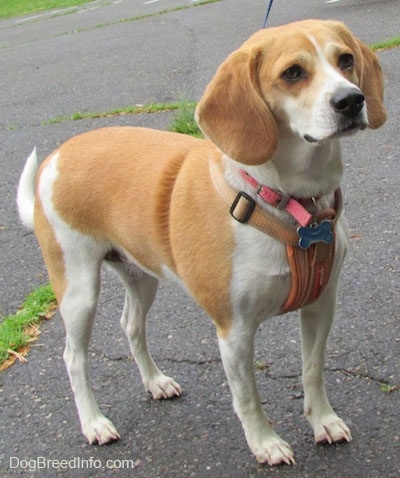
Emma the lemon and white Beagle at 3 1/2 years old
Other Names
- English Beagle
Pronunciation

Your browser does not support the audio tag.
Description
The Beagle is a sturdy, hardy little hound dog that looks like a miniature Foxhound. The body is squarely-built while the skull is fairly long and slightly domed. The square muzzle is straight and medium in length. The large eyes are brown or hazel and are set well apart. The wide, pendant ears are low set and long. The black nose is broad with full nostrils. The feet are round and firm. The tail is set moderately high and never curled over the back. The coat is of medium length, close, hard, sleek and easy to care for. Any hound-type of coloring is acceptable including lemon, tricolor, black and tan, red and white, orange and white or lemon and white, blue tick and red tick. Beagles have a distinct howl / bay of a bark when they are on the hunt. Video Clip of a Beagle's Baying Bark.
Temperament
The Beagle is loving, sweet and gentle, happy to see everyone, greeting them with a wagging tail. It is sociable, brave and intelligent. The Beagle is excellent with children and generally good with other dogs, but because of its hunting instincts, should not be trusted with non-canine pets, unless socialized with cats and other household animals when young. Beagles have minds of their own. They are determined and watchful and require patient, firm training. It is important you are this dog's pack leader and that you provide the proper amount of mental and physical exercise, including daily pack walks, to avoid separation anxiety. With enough exercise they will be calm. You can also purchase animal scents and play tracking games with your Beagle to help satisfy its instinct to track. The Beagle does not have a normal sounding bark, but rather a loud bay cry that almost sounds like a short howl. Beagles are curious and have a tendency to follow their noses. If they pick up a scent they may wander off and not even hear you calling them back, or care to listen, as they will be too busy trying to find the critter at the other end. Take care when letting them off leash that you are in a safe area. Beagles that are allowed to be pack leaders over their humans can develop a varying degree of behavior issues, including, but not limited to, guarding, obsessive barking, snapping, biting and destructive behaviors when left alone. These are not Beagle traits, but rather behaviors brought on by lack of leadership and/or exercise from their humans. The behaviors can be corrected when the dog’s instincts are met.
Height, Weight
Height: Males 14 - 16 inches (36 - 41cm) Females 13 - 15 inches (33 - 38cm)
There are two height classes, 13 - 15 inches (33 – 38 cm) and under 13 inches (33 cm).
Weight: Males 22 - 25 pounds (10 – 11 kg) Females 20 - 23 pounds (9 – 10 kg)
Health Problems
Some lines can be prone to epilepsy, heart disease, eye and back problems. Also prone to chondroplasia aka dwarfism (warped front legs, like a Basset's). See an example of chondroplasia in a dog. Prone to mast cell tumors.
Living Conditions
Beagles will do okay in an apartment if they get plenty of chances to be outdoors. They are very active indoors and a small yard will be sufficient.
Energetic and possessing great stamina, the Beagle needs plenty of exercise, including a brisk daily walk. It should have a fenced yard of reasonable size to romp in. Always use a lead when walking this breed or you will be running the risk of it disappearing in search of wild game.
Life Expectancy
About 12-15 years
Litter Size
2 - 14 puppies, average 7
The Beagle's smooth shorthaired coat is easy to look after. Brush with a firm bristle brush, and bathe with mild soap only when necessary. Dry shampoo occasionally. Be sure to check the ears carefully for signs of infection and keep the nails trimmed. This breed is an average shedder.
The first Beagles date back to the 1500s. English hunters would take packs of these dogs out on the hunt tracking rabbits, hare, pheasant, quail and other small animals. The breed probably originated as a cross between the Harrier and other types of English hounds. The dogs have since become one of the most popular breeds in the USA. The breed can hunt alone, in pairs or in packs. The name "Beagle" may have come from the French term "be’geule" which means “gape throat,” referring to the dogs baying voice. The name may also have come from the dog's size, stemming from the French word “beigh,” the Old English word “begele,” or perhaps the Celtic word “beag,” which all mean "small." He has also served as an excellent narcotics detection dog and makes a fine family companion. They were first recognized by the AKC in 1885.
Hound, AKC Hound
Recognition
- ACA = American Canine Association Inc.
- ACR = American Canine Registry
- AKC = American Kennel Club
- ANKC = Australian National Kennel Club
- APRI = American Pet Registry, Inc.
- CKC = Canadian Kennel Club
- CKC = Continental Kennel Club
- DRA = Dog Registry of America, Inc.
- FCI = FГ©dГ©ration Cynologique Internationale
- KCGB = Kennel Club of Great Britain
- NAPR = North American Purebred Registry, Inc.
- NKC = National Kennel Club
- NZKC = New Zealand Kennel Club
- UKC = United Kennel Club
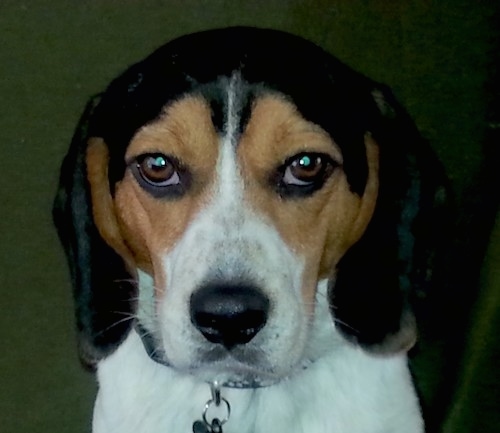
Poncho the male Beagle at 2 years old—"Poncho is a rescued dog, he was found in the floods in North Carolina, Oct. 2016. A rescue group from Pennsylvania went there and brought many dogs to PA to find homes. I adopted him in Jan. 2017. He is sweet and stubborn. He loves going to the dog park and wrestling with his friends. He is a master wrestler!! He is loved very much and we are so happy we found him!"
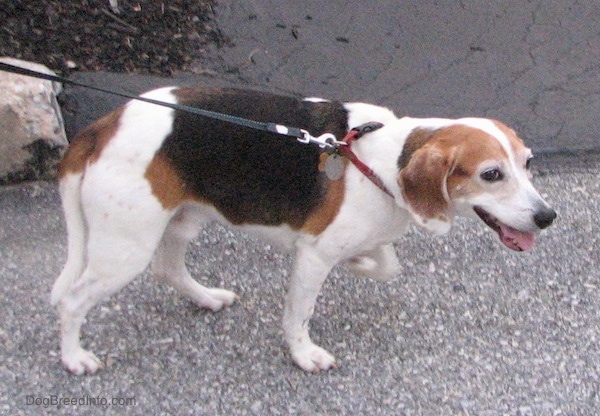
Hobbs the adult Beagle dog at 4 years old
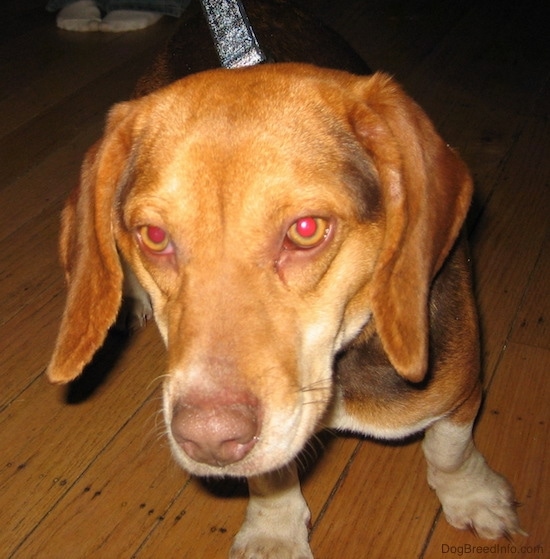
An Adult Beagle
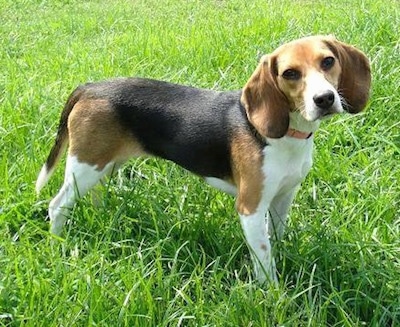
Baylee the Beagle at 8 months old—"We adopted Baylee when she was 3 months old. She has been a pleasure to have around since day one. She howls and pounces at the kitties; they don't understand that she just wants to play! She loves going for car rides, meeting new people and playing with other dogs."

Baylee the Beagle at 8 months old
Buster the male Beagle at 2 years old
"Bella is a 9 year old Beagle. We keep her in shape by strictly limiting her diet to two measured feedings per day and plenty of exercise. She is a CKC TDX tracking dog and is going to trials for her UTD tracking soon. Some people say these little suckers are difficult to train, but they are extremely intelligent and as with any dog, you have to play to their strengths. With a Beagle it is their nose and their love of finding good smelling stuff. If you have a Beagle or want one. Just a bit of time and effort and I can assure you will tracking with her. "
Bella the Beagle at 9 years old
Bella the Beagle at 9 years old
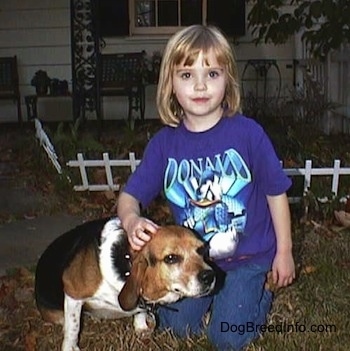
A little girl with her Beagle friend Frank
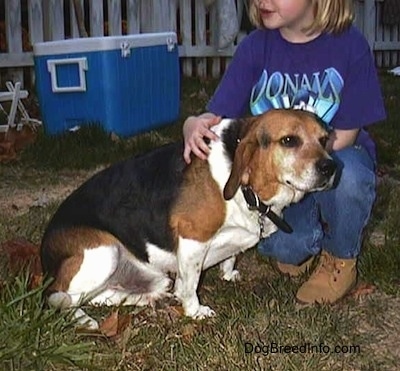
Frank the Beagle is an example of an overweight dog. It is not healthy to let your dog get fat. Since humans have control over how much a dog eats and when, any dog who is overweight is the fault of the owners. To prolong your dogs life be sure to keep them fit.
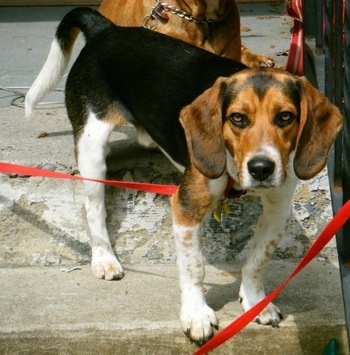
"Gunner was one and a half years old when this picture was taken. He's a 23-lb purebred beagle. We found him at the Animal Rescue League when my boyfriend and I were looking for a friend for our Pit Bull, Lucy. He is a dominant dog and was difficult to train. Like all Beagles, he has a powerful nose and can be very stubborn at times. He was hard to handle until I started a daily schedule for him: an hour long walk in the morning, breakfast, nap time, playtime, another hour long walk in the afternoon, dinner, then rest time again. He went from making messes in the house, chewing up or eating our socks, and stealing our food to behaving at home as if he was a low energy dog. It seems annoying to change your schedule around for your dog, but it's a great feeling to know that you can help release your dog's energy while bonding with him or her on a morning walk. And the more I walk Gunner, the fewer socks I have to buy."
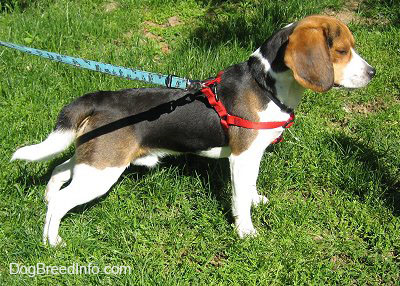
Snoopy the Beagle at 9 months old—see More of Snoopy
Kris the black and white Beagle at 1 year old
"Leo the purebred lemon Beagle—His eyes are hazel, lighter than the picture shows, almost a lemon color, and his nails are solid white."
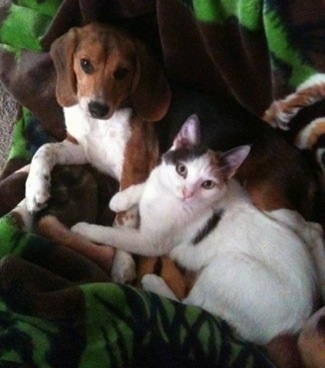
"This is Joey my Beagle with Chacha my cat. Joey is 4 months old in this picture and from the moment he was 7 weeks and we brought him home, he went after Chacha to play. He is a very friendly dog, stubborn but friendly. He cried the first night he came home and that was it, slept in his crate from the beginning. Dogbreedinfo.com has been essential since the moment I decided to get a dog, from selecting a breed and especially on How to walk your Dog, an article I constantly recommend."
"Joey always wants to be with his pack. He loves frozen carrots and all I need to distract him is to throw an ice cube on the floor. Great with kids and visitors. All and all, Joey is a real blessing. Thanks to this site I knew what to expect so I was ready when things happened, instead of getting frustrated it helped me appreciate Joey's growing steps."
Lucy the black and tan Beagle is a few years older in this picture and has started to gray. Lucy has a little white on her cheek and one foot; the rest of her is black and tan.
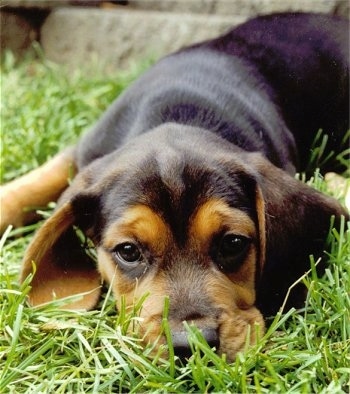
Shadow the black and tan Beagle puppy (Lucy shown above is his mother)
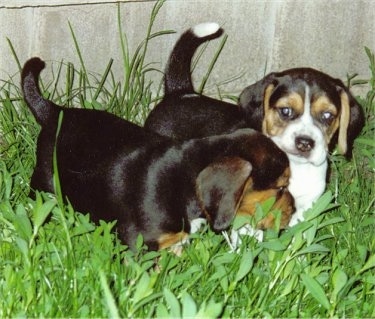
Shadow the black and tan Beagle puppy with his tricolor littermate; the mother is black and tan (Lucy, shown above) and the father is a tricolor Beagle.
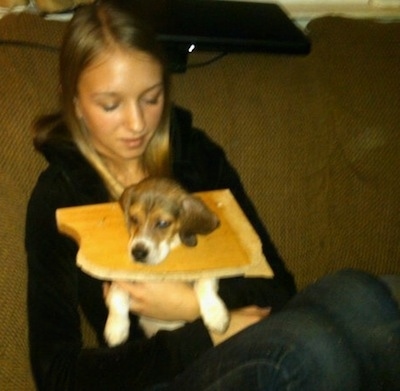
"Layla, a purebred Beagle—she was 3 months old at the time, curious about why the wires from the computer monitor went into a mysterious hole in our computer desk. Her being the curious puppy she is, she stuck her head into there and she couldn't get out! Of course, this happened on the night of a huge blizzard in NY. We had to call the police to help us get her out. It took them nearly 45 minutes to get here when they are only located 5 minutes away! We tried everything from olive oil to just simply yanking her head out but her ears were too big to get her through. We ended up having to cut the desk open with an electric saw so we could at least get her free. Then, we had to call our friend who works as a nurse at a local vet to come get her head out. Sure enough, she got her head out in a heartbeat."
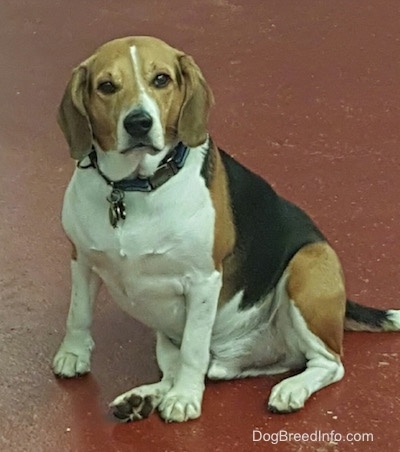
Wembly the Beagle shown here at 8 years old. He is a good bit overweight, which is hard on his joints, especially his knees. He is friendly and loves to hang out at doggie day care with all of his friends.
Breeders
The Material contained herein may not be reproduced without the prior written approval of the author. Contents & Graphics Copyright © Dog Breed Info Center® (C) 1998- . All Rights Reserved. Our work is not Public Domain.
Beagle
Small, compact, and hardy, Beagles are active companions for kids and adults alike. Canines in this dog breed are merry and fun loving, but being hounds, they can also be stubborn and require patient, creative training techniques. Their noses guide them through life, and they’re never happier than when following an interesting scent. The Beagle originally was bred as a scenthound to track small game, mostly rabbits and hare. He is still used for this purpose in many countries, including the United States.
See all Beagle characteristics below!
Additional articles you will be interested in:
Breed Characteristics:
Contrary to popular belief, small size doesn't necessarily an apartment dog make — plenty of small dogs are too high-energy and yappy for life in a high-rise. Being quiet, low energy, fairly calm indoors, and polite with the other residents, are all good qualities in an apartment dog.
Some dogs are simply easier than others: they take to training better and are fairly easygoing. They're also resilient enough to bounce back from your mistakes or inconsistencies. Dogs who are highly sensitive, independent thinking, or assertive may be harder for a first-time owner to manage. You'll get your best match if you take your dog-owning experience into account as you choose your new pooch.
Some dogs will let a stern reprimand roll off their backs, while others take even a dirty look to heart. Low-sensitivity dogs, also called "easygoing," "tolerant," "resilient," and even "thick-skinned," can better handle a noisy, chaotic household, a louder or more assertive owner, and an inconsistent or variable routine. Do you have young kids, throw lots of dinner parties, play in a garage band, or lead a hectic life? Go with a low-sensitivity dog.
Some breeds bond very closely with their family and are more prone to worry or even panic when left alone by their owner. An anxious dog can be very destructive, barking, whining, chewing, and otherwise causing mayhem. These breeds do best when a family member is home during the day or if you can take the dog to work.
Breeds with very short coats and little or no undercoat or body fat, such as Greyhounds, are vulnerable to the cold. Dogs with a low cold tolerance need to live inside in cool climates and should have a jacket or sweater for chilly walks.
Dogs with thick, double coats are more vulnerable to overheating. So are breeds with short noses, like Bulldogs or Pugs, since they can't pant as well to cool themselves off. If you want a heat-sensitive breed, the dog will need to stay indoors with you on warm or humid days, and you'll need to be extra cautious about exercising your dog in the heat.
Some breeds are independent and aloof, even if they've been raised by the same person since puppyhood; others bond closely to one person and are indifferent to everyone else; and some shower the whole family with affection. Breed isn't the only factor that goes into affection levels; dogs who were raised inside a home with people around feel more comfortable with humans and bond more easily.
Being gentle with children, sturdy enough to handle the heavy-handed pets and hugs they can dish out, and having a blasé attitude toward running, screaming children are all traits that make a kid-friendly dog. You may be surprised by who's on that list: Fierce-looking Boxers are considered good with children, as are American Staffordshire Terriers (aka pit bulls). Small, delicate, and potentially snappy dogs such as Chihuahuas aren't so family-friendly.
**All dogs are individuals. Our ratings are generalizations, and they're not a guarantee of how any breed or individual dog will behave. Dogs from any breed can be good with children based on their past experiences, training on how to get along with kids, and personality. No matter what the breed or breed type, all dogs have strong jaws, sharp pointy teeth, and may bite in stressful circumstances. Young children and dogs of any breed should always be supervised by an adult and never left alone together, period.
Friendliness toward dogs and friendliness toward humans are two completely different things. Some dogs may attack or try to dominate other dogs even if they're love-bugs with people; others would rather play than fight; and some will turn tail and run. Breed isn't the only factor; dogs who lived with their littermates and mother until at least 6 to 8 weeks of age, and who spent lots of time playing with other dogs during puppyhood, are more likely to have good canine social skills.
Stranger-friendly dogs will greet guests with a wagging tail and a nuzzle; others are shy, indifferent, or even aggressive. However, no matter what the breed, a dog who was exposed to lots of different types, ages, sizes, and shapes of people as a puppy will respond better to strangers as an adult.
If you're going to share your home with a dog, you'll need to deal with some level of dog hair on your clothes and in your house. However, shedding does vary greatly among the breeds: Some dogs shed year-round, some "blow" seasonally -- produce a snowstorm of loose hair -- some do both, and some shed hardly at all. If you're a neatnik you'll need to either pick a low-shedding breed, or relax your standards.
Drool-prone dogs may drape ropes of slobber on your arm and leave big, wet spots on your clothes when they come over to say hello. If you've got a laid-back attitude toward slobber, fine; but if you're a neatnik, you may want to choose a dog who rates low in the drool department.
Some breeds are brush-and-go dogs; others require regular bathing, clipping, and other grooming just to stay clean and healthy. Consider whether you have the time and patience for a dog that needs a lot of grooming, or the money to pay someone else to do it.
Due to poor breeding practices, some breeds are prone to certain genetic health problems, such as hip dysplasia. This doesn't mean that every dog of that breed will develop those diseases; it just means that they're at an increased risk. If you're buying a puppy, it's a good idea to find out which genetic illnesses are common to the breed you're interested in, so you can ask the breeder about the physical health of your potential pup's parents and other relatives.
Some breeds have hearty appetites and tend to put on weight easily. As in humans, being overweight can cause health problems in dogs. If you pick a breed that's prone to packing on pounds, you'll need to limit treats, make sure he gets enough exercise, and measure out his daily kibble in regular meals rather than leaving food out all the time.
Dogs come in all sizes, from the world's smallest pooch, the Chihuahua, to the towering Great Dane, how much space a dog takes up is a key factor in deciding if he is compatible with you and your living space. Large dog breeds might seem overpowering and intimidating but some of them are incredibly sweet! Take a look and find the right large dog for you!
Easy to train dogs are more adept at forming an association between a prompt (such as the word "sit"), an action (sitting), and a consequence (getting a treat) very quickly. Other dogs need more time, patience, and repetition during training. Many breeds are intelligent but approach training with a "What's in it for me?" attitude, in which case you'll need to use rewards and games to teach them to want to comply with your requests.
Dogs who were bred for jobs that require decision making, intelligence, and concentration, such as herding livestock, need to exercise their brains, just as dogs who were bred to run all day need to exercise their bodies. If they don't get the mental stimulation they need, they'll make their own work -- usually with projects you won't like, such as digging and chewing. Obedience training and interactive dog toys are good ways to give a dog a brain workout, as are dog sports and careers, such as agility and search and rescue.
Common in most breeds during puppyhood and in retriever breeds at all ages, mouthiness means a tendency to nip, chew, and play-bite (a soft, fairly painless bite that doesn't puncture the skin). Mouthy dogs are more likely to use their mouths to hold or "herd" their human family members, and they need training to learn that it's fine to gnaw on chew toys, but not on people. Mouthy breeds tend to really enjoy a game of fetch, as well as a good chew on a chew toy that's been stuffed with kibble and treats.
Some breeds sound off more often than others. When choosing a breed, think about how the dog vocalizes — with barks or howls — and how often. If you're considering a hound, would you find their trademark howls musical or maddening? If you're considering a watchdog, will a city full of suspicious "strangers" put him on permanent alert? Will the local wildlife literally drive your dog wild? Do you live in housing with noise restrictions? Do you have neighbors nearby?
Some breeds are more free-spirited than others. Nordic dogs such as Siberian Huskies were bred to range long distances, and given the chance, they'll take off after anything that catches their interest. And many hounds simply must follow their noses, or that bunny that just ran across the path, even if it means leaving you behind.
High-energy dogs are always ready and waiting for action. Originally bred to perform a canine job of some sort, such as retrieving game for hunters or herding livestock, they have the stamina to put in a full workday. They need a significant amount of exercise and mental stimulation, and they're more likely to spend time jumping, playing, and investigating any new sights and smells. Low-energy dogs are the canine equivalent of a couch potato, content to doze the day away. When picking a breed, consider your own activity level and lifestyle, and think about whether you'll find a frisky, energetic dog invigorating or annoying.
A vigorous dog may or may not be high-energy, but everything he does, he does with vigor: he strains on the leash (until you train him not to), tries to plow through obstacles, and even eats and drinks with great big gulps. These dynamos need lots of training to learn good manners, and may not be the best fit for a home with young kids or someone who's elderly or frail. A low-vigor dog, on the other hand, has a more subdued approach to life.
Some breeds do fine with a slow evening stroll around the block. Others need daily, vigorous exercise -- especially those that were originally bred for physically demanding jobs, such as herding or hunting. Without enough exercise, these breeds may put on weight and vent their pent-up energy in ways you don't like, such as barking, chewing, and digging. Breeds that need a lot of exercise are good for outdoorsy, active people, or those interested in training their dog to compete in a high-energy dog sport, such as agility.
Some dogs are perpetual puppies -- always begging for a game -- while others are more serious and sedate. Although a playful pup sounds endearing, consider how many games of fetch or tag you want to play each day, and whether you have kids or other dogs who can stand in as playmates for the dog.
Vital Stats:
Height: 1 foot, 1 inch to 1 foot, 3 inches tall at the shoulder
Weight: 18 to 30 pounds
Life Span: 10 to 15 years
Highlights
- Beagles can be difficult to housetrain. Some people say it can take up to a year to fully housetrain some Beagles. Crate training is absolutely recommended.
- Beagles can get bored if left alone in a house too long. If left in a backyard, Beagles will start finding ways to amuse themselves, usually by howling, digging, or trying to escape.
- The most common reason Beagles are turned over to rescue groups is because either their owners or their owners' neighbors got tired of their baying. Be sure that you are prepared to work with your dog to control excessive barking and howling.
- Beagles are targets for thieves who would steal them and perhaps sell them to research laboratories for use in experiments. Supervise your Beagle when he is outdoors and be sure to have him microchipped!
- Since they are scenthounds, Beagles will wander off if they catch an enticing smell in the air. Their noses control their brains, and if they smell something interesting, nothing else exists in their world.
- Although they are loving and gentle, Beagles can have an independent, stubborn streak. Obedience training is recommended, but be sure the instructor of the class understands hound personality and favors using food as a reward (which few Beagles can resist).
- Do you remember how the famous cartoon Beagle Snoopy worried about his food bowl? Beagles are "chow hounds" and will overeat if given a chance. Monitor the amount of food you give them and be sure to keep your cupboards closed and your trashcans secured. Otherwise, your Beagle will sniff out the foods he likes the best.
- In regards to food, your Beagle probably will take its food bowl pretty seriously. Teach children to respect your Beagle while it is eating, and not to approach it or tease it with food.
- Beagles are not good protection or guard dogs because they're usually friendly to everyone they meet.
Personality
Feeding
Coat Color And Grooming
Children And Other Pets
Rescue Groups
Breed Organizations
Around The Web
Breed Profile Finder
Dogtime is a property of TotallyHer Media, LLC, an Evolve Media, LLC company. © 2018 All rights reserved.
Social Sharing
Share this on social media
Finally, a hybrid that doesn’t drive like one.
Our hybrid is efficient just like any other hybrid.www.fueleconomy.gov for EPA estimates. Your mileage will vary and depends on several factors, including your driving habits and vehicle condition.">]'>1 But we decided to make our hybrid the one you’d actually want to drive. So while you’ll feel good about the gas you’re saving, now you can also have fun while you do it.
Dubchat Jetta Hybrid Power Meter :15
Dubchat Jetta Hybrid Coasting :15
Being fuel-efficient has never been so much fun.
Sure, the Jetta Hybrid is fuel-efficient and gets 48 hwy mpg,42 city/48 highway mpg (2016 Jetta Hybrid, 7-speed DSGВ® automatic transmission). EPA estimates. Your mileage will vary and depends on several factors, including your driving habits and vehicle condition.
">]'>1 but it’s also turbocharged. Which means you can pass up quite a few gas stations. And a lot of other hybrids too.
Beetle hund
Pug / Boston Terrier Mixed Breed Dogs
Information and Pictures
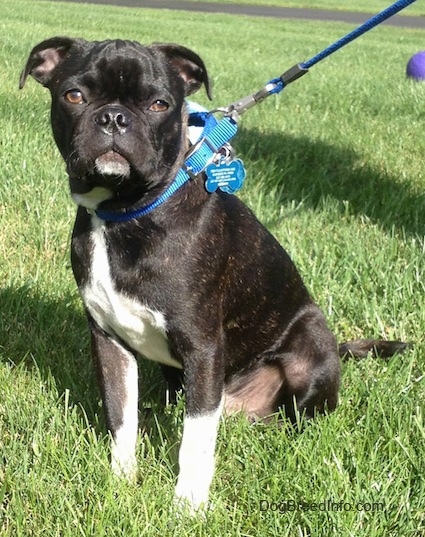
Murphy the Bugg (1/2 Boston Terrier 1/2 Pug) puppy at 6 months old
Other Names
- Buggs
- Bug
- Pugin
Description
The Bugg is not a purebred dog. It is a cross between the Pug and the Boston Terrier. The best way to determine the temperament of a mixed breed is to look up all breeds in the cross and know you can get any combination of any of the characteristics found in either breed. Not all of these designer hybrid dogs being bred are 50% purebred to 50% purebred. It is very common for breeders to breed multi-generation crosses.
Recognition
- ACHC = American Canine Hybrid Club
- DBR = Designer Breed Registry
- DDKC = Designer Dogs Kennel Club
- DRA = Dog Registry of America, Inc.
- IDCR = International Designer Canine Registry ®
Recognized Names
- American Canine Hybrid Club = Buggs
- Designer Breed Registry = Buggs
- Designer Dogs Kennel Club = Buggs
- International Designer Canine Registry ® = Bugg

Jake the Boston Terrier / Pug mix at 10 months old sitting in the passenger's seat of a Jeep—"He is our little hyper cuddle bugg. He loves sleeping in, going for jeep rides, bouncing off the walls while playing. He is Very playful and loving it's never a dull moment with him. Constantly getting into stuff. Some of his bad habits are chewing and licking everything.”
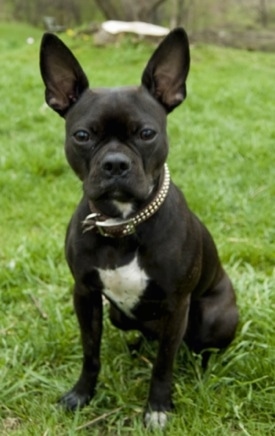
"This is our fabulous Lucie, our Bugg at 3 years old. This is a picture I took in a park in Laval, Canada. We instantly fell in love with this 20-pound athlete 2 and a half years ago. I just said athlete because this dog can jump up 4 feet high. I also teach her to play dead, high five, dance and speak. Very intelligent dog, for sure. She is perfect for children, even if I play rough with her, she completely switches her playing ways when children are around.”
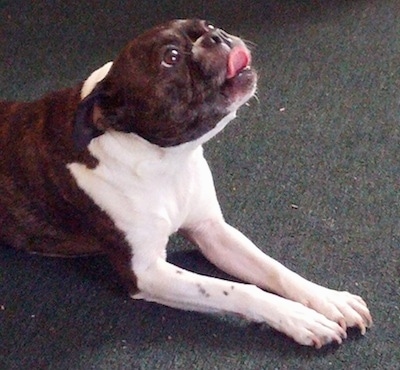
"Butch is a Boston Terrier / Pug hybrid shown here at 7 years old. Many breeders call Butch's breed a Bugg or Buggs, although Butch's breeder called him a Pugin. Butch has been a service animal for almost 4 years and he is very good at it. Butch doesn't do naughty things. Most of the time he is a perfect little angel, but daddy makes sure he doesn't forget! Butch has added so much love to not just to our lives, but the lives of our entire family. We could not ask for more from Butch, he is just a little ball of love and peace."
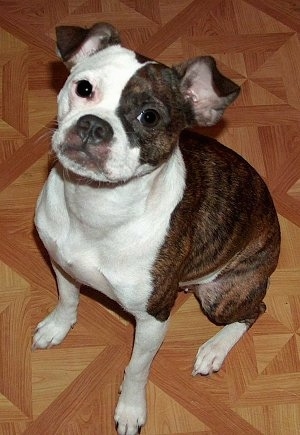
Nicky the Bugg (Boston Terrier / Pug hybrid) at 1 ½ years old takes more after her mother (the Boston Terrier) than her dad (the pug). "She doesn't know she is a dog. She is my daughter’s best friend."
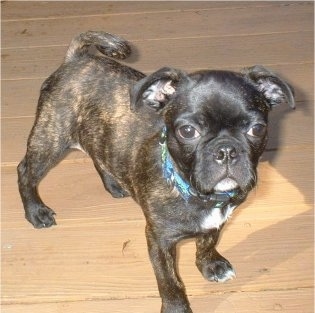
Harley the Bugg (Boston Terrier / Pug mix) puppy
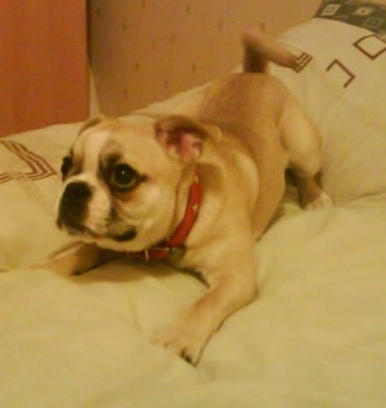
"This is my lovely Bugg Dolly at 6 months old. She is very energetic and very sweet natured."
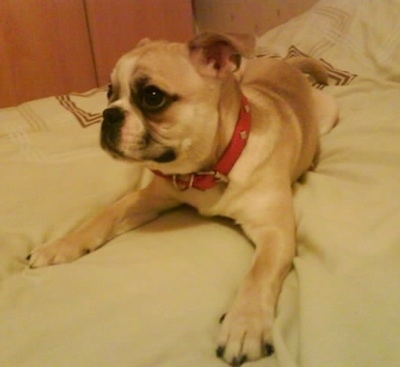
Dolly the Bugg at 6 months old
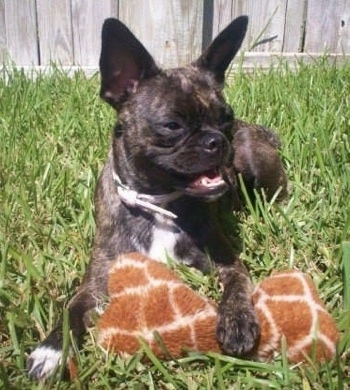
"Bailey the Bugg at 1 year and 4 months old is full of energy as always. She still loves undies and the outdoors. This is her playing in the yard with one of her favorite toys. Her favorites are the ones with loud squeakers in them."
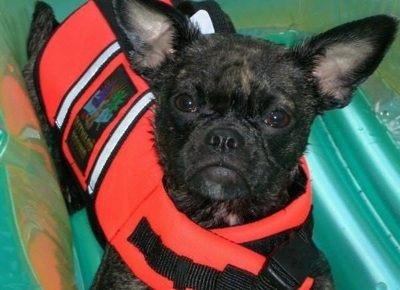
"Bailey the Bugg at 1 year and 4 months old around the pool. This is her in her boat with her life jacket on. She doesn’t like the water very much, other than just sitting on the steps. However, she has taken up floating around the pool in her boat."
"This is Bailey. She is a Bugg. She is about 8 months old now. Her temperament is well-rounded. She is a bit high-strung, but remember, she is still a puppy. Plus I love that she keeps me on my toes. I love her to death. Just a great personality and a great companion."
Bailey is about 8 months old and weighs 11 pounds in this picture. She was the runt of her litter. She loves to chew on panties. doesn't matter what kind. she's a little undies stealer."
"She also likes to sit on the first step of our pool to relax. She is still unsure about swimming but is more than willing to take a dip to cool off."
"Bailey also unfortunately broke her leg in two places when she was about 4 months old. Due to her spunky personality and a love for life she was back to her original self in no time."
Bailey the Bugg (Boston Terrier / Pug hybrid) getting a bath and waiting OUT of the tub!
Barnaby the 3-year-old Bugg
Barnaby the 3-year-old Bugg
Breeders
The Material contained herein may not be reproduced without the prior written approval of the author. Contents & Graphics Copyright © Dog Breed Info Center® (C) 1998- . All Rights Reserved. Our work is not Public Domain.
Animal Diversity Web
More Information
Additional Information
Spirocerca lupi
Geographic Range
Spirocerca lupi , the esophageal worm, is a mammalian parasite found in the tropic warm temperate areas and throughout the United States. Their distribution is sporadic, as they have also been found in northern regions of the Soviet Union and Manchuria. (Frisby, 2001; Roberts and Janovy, 2000)
Spirocera lupi most commonly plauge canids and wild felids in warm climates. However they have also been found in northern regions of the Soviet Union and Manchuria. (Roberts and Janovy, 2000)
Physical Description
Spirocerca lupi adults are cylindrical and range from a bright pinkish to red color. The mouth is sorrounded by six lips. Spirocerca lupi also have a well developed buccal capsule with thick walls. Females are approximately 5 to 8 cm long while males are slightly smaller, 3 to 5. 5 cm long. Cyndrical encapsulated juveniles that are passed out through the definitive host feces are 30-38 x 11-15 micrometers.
An outer cuticle has three main non-cellular outer layers made of collagen and other compounds that are secreted by the epidermis. The cuticle layer protects the nematodes so they can invade the digestive tracts of animals.
Nematodes have longitudinal muscles along the body wall. The muscles are obliquely arranged in bands. Dorsal, ventral and longitudinal nerve cords are connected to the main body of the muscle. (Brusca and Brusca, 2003; Roberts and Janovy, 2000)
Development
Embroynated S. lupi eggs exit the definitive host via feces. An intermediate host, a coprophagous (dung-eating) beetle, ingests the eggs while feeding. Inside the egg, the larva develops into an infective third stage and encyst in the intermediate host's tissues. The beetle is then eaten by a definitive host or by a paratenic host (lizard, chicken or mouse), which in turn is eaten by a definitive host. The third stage larva penetrates the stomach wall of the definitive host and migrates through the gastric wall and continues until it reaches the thoracic aorta within 20 days. It remains in the thoracic aorta for 2 to 3 months. After further development, they move to the esophagus where the larva becomes surrounded by a cystic nodule. At this point they can further develop and reach sexual maturity. (Frisby, 2001; Roberts and Janovy, 2000)
Reproduction
Adults are often found in clusters where mating occurs. Spirocera lupi are dioecious and after male and female find each other, via chemotactic an thigmotactic mechanisms, the males caudal papillae detects the female vulva. The male coils around a female with his curved area over the female genital pore. Males have copulatory spicules which they insert into the vulva. They do not conduct sperm, but hold the vulva open while the ejaculatory muscles inject sperm into her reproductive tract. Nematode sperm are amoeboid-like and lack flagella. (Brusca and Brusca, 2003; Pearse and Pearse, 1987; Roberts and Janovy, 2000)
Spirocerca lupi migrate through their host by contracting and relaxing dorsal and ventral muscles. This forces the body into a series of curves producing an s-shaped motion. Adults are often found in clusters where mating occurs. Spirocera lupi are dioecious and after male and female find each other, via chemotactic an thigmotactic mechanisms, the males caudal papillae detects the female vulva. Males have copulatory spicules which they insert into the vulva. They do not conduct sperm, but hold the vulva open while the ejaculatory muscles inject sperm into her reproductive tract. (Pearse and Pearse, 1987; Roberts and Janovy, 2000)
Communication and Perception
Nematodes within the Secernentea have phasmids, which are unicellular glands. Phasmids likely function as chemoreceptors. Females may produce pheromones to attract males.
Nematodes in general have papillae, setae and amphids as the main sense organs. Setae detect motion (mechanoreceptors), while amphids detect chemicals (chemoreceptors). (Brusca and Brusca, 2003; Roberts and Janovy, 2000)
Food Habits
Parasitic nematodes feed on blood, tissue cells and fluid, intestinal contents or some combination of these. They also feed extravagantly with much waste. Spirocera lupi ingest food through their six lip mouth. A wave of muscle contractions pulls food into the digestive system. Pharyngeal glands and intestinal epithelium produce digestive enzymes to feed on the body fluids. Extracellular digestion begins within the lumen and is finished intracellularly. (Brusca and Brusca, 2003; Pearse and Pearse, 1987; Roberts and Janovy, 2000)
These parasites are usually not preyed on directly, but are ingested from host to host. Larval mortality is high as most of the parasites do not reach appropriate hosts.
Ecosystem Roles
Spirocerca lupi eggs exit the definitive host (canine) via feces. An intermediate host, a coprophagous (dung-eating) beetle, ingests the eggs while feeding. Inside the egg, the larva develops into an infective third stage and encyst in the intermediate host's tissues. The beetle is then eaten by a definitive host or by a paratenic host (lizard, chicken or mouse), which in turn is eaten by a definitive host. (Frisby, 2001; Roberts and Janovy, 2000)
Economic Importance for Humans: Negative
Dogs infected with the esophageal worm can be severely damaged and even die. Nodules in an infected host can inhibit swallowing, breathing, and blood circulation. The dog may lose its appetite and weight or even have an aneurysm. Spirocerca lupi may also lead to the development of cancer and occasionally hypertrophic pulmonary osteopathy, inflamed and swollen joints. (Frisby, 2001; Roberts and Janovy, 2000)
Other Comments
Signs of infection in dogs are vomiting, weight loss, and hemoptysis (coughing and spitting up blood). Eggs of S. lupi can also be found in feces or vomit. Endoscopic exams and x-rays can reveal the presence of nodules caused by the esophageal worm. Veterinarians treat infected animals with the drug disophenol. However, irreversible damage, such as a severe aneurysm or cancer cannot be treated effectively. (Frisby, 2001; Roberts and Janovy, 2000)
Contributors
Renee Sherman Mulcrone (editor).
Jemiah Cameron (author), University of Michigan-Ann Arbor, Teresa Friedrich (editor), University of Michigan-Ann Arbor.
living in the Nearctic biogeographic province, the northern part of the New World. This includes Greenland, the Canadian Arctic islands, and all of the North American as far south as the highlands of central Mexico.
living in the northern part of the Old World. In otherwords, Europe and Asia and northern Africa.
having body symmetry such that the animal can be divided in one plane into two mirror-image halves. Animals with bilateral symmetry have dorsal and ventral sides, as well as anterior and posterior ends. Synapomorphy of the Bilateria.
an animal that mainly eats meat
either directly causes, or indirectly transmits, a disease to a domestic animal
Found in coastal areas between 30 and 40 degrees latitude, in areas with a Mediterranean climate. Vegetation is dominated by stands of dense, spiny shrubs with tough (hard or waxy) evergreen leaves. May be maintained by periodic fire. In South America it includes the scrub ecotone between forest and paramo.
uses smells or other chemicals to communicate
animals which must use heat acquired from the environment and behavioral adaptations to regulate body temperature
union of egg and spermatozoan
forest biomes are dominated by trees, otherwise forest biomes can vary widely in amount of precipitation and seasonality.
having a body temperature that fluctuates with that of the immediate environment; having no mechanism or a poorly developed mechanism for regulating internal body temperature.
fertilization takes place within the female's body
having the capacity to move from one place to another.
found in the oriental region of the world. In other words, India and southeast Asia.
reproduction in which eggs are released by the female; development of offspring occurs outside the mother's body.
an organism that obtains nutrients from other organisms in a harmful way that doesn't cause immediate death
chemicals released into air or water that are detected by and responded to by other animals of the same species
rainforests, both temperate and tropical, are dominated by trees often forming a closed canopy with little light reaching the ground. Epiphytes and climbing plants are also abundant. Precipitation is typically not limiting, but may be somewhat seasonal.
scrub forests develop in areas that experience dry seasons.
remains in the same area
reproduction that includes combining the genetic contribution of two individuals, a male and a female
uses touch to communicate
Coniferous or boreal forest, located in a band across northern North America, Europe, and Asia. This terrestrial biome also occurs at high elevations. Long, cold winters and short, wet summers. Few species of trees are present; these are primarily conifers that grow in dense stands with little undergrowth. Some deciduous trees also may be present.
that region of the Earth between 23.5 degrees North and 60 degrees North (between the Tropic of Cancer and the Arctic Circle) and between 23.5 degrees South and 60 degrees South (between the Tropic of Capricorn and the Antarctic Circle).
the region of the earth that surrounds the equator, from 23.5 degrees north to 23.5 degrees south.
A terrestrial biome. Savannas are grasslands with scattered individual trees that do not form a closed canopy. Extensive savannas are found in parts of subtropical and tropical Africa and South America, and in Australia.
A grassland with scattered trees or scattered clumps of trees, a type of community intermediate between grassland and forest. See also Tropical savanna and grassland biome.
A terrestrial biome found in temperate latitudes (>23.5° N or S latitude). Vegetation is made up mostly of grasses, the height and species diversity of which depend largely on the amount of moisture available. Fire and grazing are important in the long-term maintenance of grasslands.
A terrestrial biome with low, shrubby or mat-like vegetation found at extremely high latitudes or elevations, near the limit of plant growth. Soils usually subject to permafrost. Plant diversity is typically low and the growing season is short.
References
Brusca, R., G. Brusca. 2003. Invertebrates . Sunderland, Massachusetts: Sinauer Associates, Inc..
Frisby, H. 2001. Spirocera Lupi. Foster and Smtih Pet Education , 81: 221-222.
Hamir, A. 1987. Esophageal perforation and phyothorax associatated with Spirocerca lupi infestation ina dog. The Veterinary Record , 19: 276.
Harris, S. 1996. Spirocerca lupi infection in the dog: abberant migration. The Journal of the American Animal Hospital Association , 32: 125-30.
Nolan, T. 2004. "Spirocerca lupi Homepage" (On-line). Diagnosis of Veterinary Endoparasitic Infections. Accessed September 28, 2004 at http://cal.vet.upenn.edu/dxendopar/parasitepages/filariidsandspirurids/s_lupi.html.
Pearse, V., J. Pearse. 1987. Living Invertebrae . Boston, Mass: Blackwell Publications.
Roberts, L., J. Janovy. 2000. Foundations of Parasitology . Boston: McGraw Hill.
The Animal Diversity Web team is excited to announce ADW Pocket Guides!
Connect with us
Navigation Links
Classification
- Kingdom Animalia animals
To cite this page: Cameron, J. 2003. "Spirocerca lupi" (On-line), Animal Diversity Web. Accessed February 23, 2018 at http://animaldiversity.org/accounts/Spirocerca_lupi/
Disclaimer: The Animal Diversity Web is an educational resource written largely by and for college students. ADW doesn't cover all species in the world, nor does it include all the latest scientific information about organisms we describe. Though we edit our accounts for accuracy, we cannot guarantee all information in those accounts. While ADW staff and contributors provide references to books and websites that we believe are reputable, we cannot necessarily endorse the contents of references beyond our control.
- U-M Gateway | U-M Museum of Zoology
- U-M Ecology and Evolutionary Biology
- © 2014 Regents of the University of Michigan
- Report Error / Comment
This material is based upon work supported by the National Science Foundation Grants DRL 0089283, DRL 0628151, DUE 0633095, DRL 0918590, and DUE 1122742. Additional support has come from the Marisla Foundation, UM College of Literature, Science, and the Arts, Museum of Zoology, and Information and Technology Services.
The ADW Team gratefully acknowledges their support.
Knuffliger Autositz für Hund, Katze oder Haustier inkl. Gurt und Sitzbefestigung empfohlen für VW B0744GDRF7 B0744GDRF7
- ca. Abmessungen 50x55x20cm (Tiefe x Breite x Randhöhe)
- Speziell für Fahrzeuge mit einer hochwertigen Innenausstattung. Der Leder-Look wirkt nicht nur sehr hochwertig, auch die Verarbeitung ist sehr hochwertig
- Die flauschige Kuscheleinlage ist herausnehmbar und bei 30° waschbar, ebenso ist das Hundebett abwaschbar
- Die flauschige Kuscheleinlage ist herausnehmbar und bei 30° waschbar, ebenso ist das Hundebett abwaschbar
- Infos zum Hundegurt: DEHNBAR, FLEXIBEL & RUCKABSORBIEREND – Zusätzlicher Schutz vor Verletzungen durch den dehnbaren und flexiblen Gummizug. Das stabile Gummi gewährt ausreichend Elastizitätsspielraum und absorbiert die starken Kräfte bei plötzlichen Brems- und Ausweichmanövern. Der Sicherheitsgurt für Hunde und Katzen im Auto ist stufenlos größenverstellbar und für kleine & große Haustiere geeignet
Produktbeschreibungen
Knuffliger Leder-Look Autositz für Hund, Katze oder Haustier inkl. Flexgurt empfohlen für VW Caddy II Kombi
ACHTUNG: Dieser Leder-Look Autositz wird hier als universell verwendbar angeboten. Bei unserer Fahrzeugempfehlung handelt es sich lediglich um eine Empfehlung und um keine Garantie das dieser Artikel auch zu 100% passt.
- ca. Abmessungen 50 x 55 x 20cm (Tiefe x Breite x Randhöhe)
- Leder-Look Optik, u.a. auch für hochwertigere Innenausstattungen geeignet
- Durch den integrierten Haltegurt ist der tierische Beifahrer perfekt gesichert. Karabiner einfach am Hundehalsband einhängen - fertig
- Mit Hilfe der flexiblen Gummibänder ist eine feste Montage garantiert. Der Einbau ist kinderleicht und dauert keine Minute
- Die flauschige Kuscheleinlage ist herausnehmbar und bei 30° waschbar
- Die Qualität ist sehr hochwertig, es gibt KEINE chemischen o.ä. unangenehme Materialgerüche
- Das Innenkissen ist gefüttert und passt sich somit der Körperform des Tieres problemlos an. Der Sitz ist aus 100% Polyester gefertigt, ist leicht zu verstauen und findet auch bei Reisen schnell einen Platz im Gepäck
Zun diesem Paket gehört auch:
Premium Hunde-Sicherheitsgurt - Wertbeständiger Chrom-Verschluss und elastische Ruckdämpfung, idealer Autogurt-Adapter für Hunde-Geschirr oder Halsband, perfekter Anschnallgurt für höchste Sicherheit
Unser Sicherheitsgurt für Haustiere dient der Sicherheit Ihres Vierbeiners und aller anderen Insassen des Fahrzeugs. Beim plötzlichen Bremsen oder sogar bei Unfällen kann es passieren, dass sich Ihr Vierbeiner oder auch Ihre Mitfahrer verletzen. Der Gurt-Adapter hilft Ihnen dabei, das Verletzungsrisiko zu verringern. Die Breite beträgt 26 mm.
Der Adapter ist verstellbar von 62 bis 88 cm und ist für große sowie kleine Hunde geeignet.
Dame Wallis
I've never watched a single episode of Mad Men and I don't intend to. But I'm glad you like it.

Tagged with Volkswagen
Rainbow Butts
The floodgates have opened. Advertisers have been posting their Super Bowl ads well in advance of the big game. And true to form, Volkswagen releases another great ad. Mind you it’s not as great as the Darth Vader ad from 2012, but any time you can work rainbows shooting out of people’s butts, you get my vote.
Watch Out For That Tree!
I’m pretty certain this ad might even be pushing it a little for the Volkswagen brand, but who gives a damn. It’s funny.
They’re not groundbreaking, but I really like the simplicity of this series of Volkswagen ads from AlmapBBDO, Argentina to launch Side Assist technology.
Trolo-A-Go-Go
Cute spot for the new Beetle Convertible, called ‘Mask’. Created by Deutsch, LA. My favorite part? The fact that they’re playing Trololo as the background music in the store. Two thumbs up.
Get Happy vs. Das Hund
Hello, Chefs. There are two dishes on the chopping block today. Both prepared for us by Volkswagen.
The first, Volkswagen’s ‘Get Happy’ spot by Deutsch LA. Which is supposed to be their Super Bowl spot, but was released early and is now “causing a lot of controversy” – this according to news sources.
WHAT? Who finds this controversial? Whoever it was probably confused the word “controversial” with the word “mediocre”. Please. This spot is about as controversial as my last pedicure. Is it good? No. Did I pay too much for what I got? Probably. Is it repulsive? Not at all. It will pass if no one looks too closely. But I won’t be going there again.
DDB Amsterdam brings us the next Volkswagen spot. Which I must say is leaps and bounds (or kibbles and bits) better than the first spot I made you sit through.
Beetle hund
- Interface:
- English
- Français
- Español
- Deutsch
- Italiano
- Português
- Reverso Context Mobile app
- Conditions of use
- Copyright
ein flotter Käfer a nice bit of skirt (Brit) inf inf , a real babe
Results found in: English-German
- he crunched the beetle/ice/gravel underfoot exp. der Käfer zerknackte/das Eis zersplitterte/der Kies knirschte unter seinen Füßen
Examples and translations in context
Alphabetical index
Welcome to German-English Collins dictionary. Type the word that you look for in the search box above. The results will include words and phrases from the general dictionary as well as entries from the collaborative one.
Beetle hund
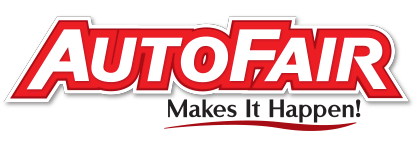
New Inventory
Bodystyle Selector
Pre-Owned Inventory
Featured Vehicles
AutoFair Advantage
Research New Fords
Research New Hondas
Research New Hyundais
Research New Nissans
Research New Subarus
Research New Volkswagens
Our Dealership
- Access your saved cars on any device.
- Receive Price Alert emails when price changes, new offers become available or a vehicle is sold.
Enter your registered email address to request a password reset link.
- Access your saved cars on any device.
- Receive Price Alert emails when price changes, new offers become available or a vehicle is sold.
- Access your saved cars on any device.
- Receive Price Alert emails when price changes, new offers become available or a vehicle is sold.
Search Inventory
Select Dealership
200 Keller Street Manchester , NH 03103
Sales : (866) 417-2431
1477 S. Willow Street Manchester , NH 03103
Sales : (866) 800-6535
Service : (866) 857-0929
(Located at Autofair Hyundai) 1477 S Willow Street Manchester , NH 03103
Sales : (866) 414-7781
95 Drum Hill Rd. Chelmsford , MA 01824
Sales : (888) 348-8169
Service : (877) 730-5814
45 Portsmouth Ave Route 33 to 108 | Route 101, Exit 11 Stratham , NH 03885
Sales : (888) 698-1456
Service : (888) 703-7296
503 Broadway Haverhill , MA 01832
Sales : (888) 804-7505
Service : (888) 806-0758
1475 South Willow Street Manchester , NH 03103
Комментариев нет:
Отправить комментарий